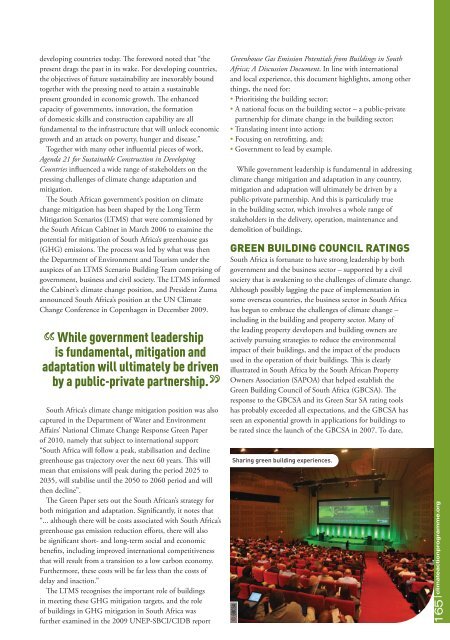Climate Action 2011-2012
Create successful ePaper yourself
Turn your PDF publications into a flip-book with our unique Google optimized e-Paper software.
developing countries today. The foreword noted that “the<br />
present drags the past in its wake. For developing countries,<br />
the objectives of future sustainability are inexorably bound<br />
together with the pressing need to attain a sustainable<br />
present grounded in economic growth. The enhanced<br />
capacity of governments, innovation, the formation<br />
of domestic skills and construction capability are all<br />
fundamental to the infrastructure that will unlock economic<br />
growth and an attack on poverty, hunger and disease.”<br />
Together with many other influential pieces of work,<br />
Agenda 21 for Sustainable Construction in Developing<br />
Countries influenced a wide range of stakeholders on the<br />
pressing challenges of climate change adaptation and<br />
mitigation.<br />
The South African government’s position on climate<br />
change mitigation has been shaped by the Long Term<br />
Mitigation Scenarios (LTMS) that were commissioned by<br />
the South African Cabinet in March 2006 to examine the<br />
potential for mitigation of South Africa’s greenhouse gas<br />
(GHG) emissions. The process was led by what was then<br />
the Department of Environment and Tourism under the<br />
auspices of an LTMS Scenario Building Team comprising of<br />
government, business and civil society. The LTMS informed<br />
the Cabinet’s climate change position, and President Zuma<br />
announced South Africa’s position at the UN <strong>Climate</strong><br />
Change Conference in Copenhagen in December 2009.<br />
While government leadership<br />
is fundamental, mitigation and<br />
adaptation will ultimately be driven<br />
by a public-private partnership.<br />
South Africa’s climate change mitigation position was also<br />
captured in the Department of Water and Environment<br />
Affairs’ National <strong>Climate</strong> Change Response Green Paper<br />
of 2010, namely that subject to international support<br />
“South Africa will follow a peak, stabilisation and decline<br />
greenhouse gas trajectory over the next 60 years. This will<br />
mean that emissions will peak during the period 2025 to<br />
2035, will stabilise until the 2050 to 2060 period and will<br />
then decline”.<br />
The Green Paper sets out the South African’s strategy for<br />
both mitigation and adaptation. Significantly, it notes that<br />
“... although there will be costs associated with South Africa’s<br />
greenhouse gas emission reduction efforts, there will also<br />
be significant short- and long-term social and economic<br />
benefits, including improved international competitiveness<br />
that will result from a transition to a low carbon economy.<br />
Furthermore, these costs will be far less than the costs of<br />
delay and inaction.”<br />
The LTMS recognises the important role of buildings<br />
in meeting these GHG mitigation targets, and the role<br />
of buildings in GHG mitigation in South Africa was<br />
further examined in the 2009 UNEP-SBCI/CIDB report<br />
Greenhouse Gas Emission Potentials from Buildings in South<br />
Africa; A Discussion Document. In line with international<br />
and local experience, this document highlights, among other<br />
things, the need for:<br />
• Prioritising the building sector;<br />
• A national focus on the building sector – a public-private<br />
partnership for climate change in the building sector;<br />
• Translating intent into action;<br />
• Focusing on retrofitting, and;<br />
• Government to lead by example.<br />
While government leadership is fundamental in addressing<br />
climate change mitigation and adaptation in any country,<br />
mitigation and adaptation will ultimately be driven by a<br />
public-private partnership. And this is particularly true<br />
in the building sector, which involves a whole range of<br />
stakeholders in the delivery, operation, maintenance and<br />
demolition of buildings.<br />
Green BuildinG CounCil ratinGs<br />
South Africa is fortunate to have strong leadership by both<br />
government and the business sector – supported by a civil<br />
society that is awakening to the challenges of climate change.<br />
Although possibly lagging the pace of implementation in<br />
some overseas countries, the business sector in South Africa<br />
has begun to embrace the challenges of climate change –<br />
including in the building and property sector. Many of<br />
the leading property developers and building owners are<br />
actively pursuing strategies to reduce the environmental<br />
impact of their buildings, and the impact of the products<br />
used in the operation of their buildings. This is clearly<br />
illustrated in South Africa by the South African Property<br />
Owners Association (SAPOA) that helped establish the<br />
Green Building Council of South Africa (GBCSA). The<br />
response to the GBCSA and its Green Star SA rating tools<br />
has probably exceeded all expectations, and the GBCSA has<br />
seen an exponential growth in applications for buildings to<br />
be rated since the launch of the GBCSA in 2007. To date,<br />
Sharing green building experiences.<br />
© GBCSA<br />
165 climateactionprogramme.org












